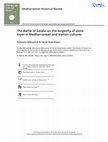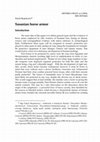Papers by Patryk N Skupniewicz
PARTHICA, 2024
In 2023, an article by Samra Azarnouche and Frantz Grenet analysed the scene on the Sasanian silv... more In 2023, an article by Samra Azarnouche and Frantz Grenet analysed the scene on the Sasanian silver plate depicting a mounted king killing ostriches, and concluded that the scene depicted the events from youth of Shapur II who confronted and pacified the Arab tribes threatening the Sasanian realm from the south. Such conclusions were made without proper iconographic analysis, and the historical reasoning contains several flaws. The present paper aims at a reinterpretation of the scene. The scene is unusual in Sasanian toreutics, as in no other example of Sasanian art in general one may find the combination of the beardless proponent hunting the ostriches. Contemporary authors deny the historical reference of the scene, pointing to narrative literature as providing a more credible interpretation.
Persica Antiqua. The International Journal of Ancient Iranian Studies, 2025
The silver plate from the British Museum (inv. 124091) usually attributed as depicting "Šābuhr ki... more The silver plate from the British Museum (inv. 124091) usually attributed as depicting "Šābuhr killing deer"does not have a direct parallel in Sasanian iconography. The attempts were made to explain the image in perspective of relation to Mithraism, however no detailed analysis was done. The plate represents features typical for the Sasanian silver but, at the same time it is modelled upon Mithraic tauroctony. This makes the scene a possibly important argument in discussion regarding the very existence of Iranian Mithraism. The fact that the scene is not a direct copy of the Roman tauroctony arguments for association with Iranian imagery. The scene had to be understood in Iranian terms, despite referring to Roman depictions. This supports the view of Iranian, pre-Zoroastrian Mithraic cult.

Mediterranean Historical Review, 2024
The Battle of Satala was one of the important clashes of late Antiquity, with political consequen... more The Battle of Satala was one of the important clashes of late Antiquity, with political consequences of great importance. However, the sources do not allow the reconstruction of the clash or the course of the campaign. The analysis of the textual material reveals that it contains literary topoi that can be associated with the stories of the Romance of Alexander. Similarly, when studied from the perspective of the history of art, the sculptural reliefs with the combat depictions on the Arch of Galerius in Thessaloniki show their conventional character and strong relation to the Hellenistic models. The conclusion is made that Galerius intentionally stylized himself as Alexander, referring to the well-known narrative, widely circulating in the eastern part of the empire, and whose aesthetics were familiar to the inhabitants of that region. The message expressed both textually and visually was well addressed and targeted the audience under Galerius’s rule. The fact that the most “detailed” description of the Battle of Satala comes from Armenian sources and is set within oriental topoi indicates that such communication had already been deeply rooted and thus could be an example of a well-designed and skilfully executed work of propaganda.

Brill’s Companion to War in the Ancient Iranian Empires, 2024
The development of the arms and armour of the pre-Islamic Iranian empires clearly marks the cultu... more The development of the arms and armour of the pre-Islamic Iranian empires clearly marks the cultural changes taking place over a period of twelve centuries, and the number of influences which inspired their evolution. Sadly, there is only a scanty amount of preserved examples of Iranian weapons from the period under discussion. Any study of ancient Iranian arms and armour must rely heavily on literary sources and iconography which often prove discrepant. Such a study cannot, therefore, be carried as a classical research of arms and armour and must include an examination of the formal aspects of both art and literature. Such a critical approach should result not only in reliable reconstruction of the panoply of Persian warriors, and the connections of particular items with influencing or influenced cultures, but also the cultural significance of the weapons and the relationship between art and actual weapons and combat techniques.

Mediterranean Historical Review 39-2, 2024
The Battle of Satala was one of the important clashes of late Antiquity, with political consequen... more The Battle of Satala was one of the important clashes of late Antiquity, with political consequences of great importance. However, the sources do not allow the reconstruction of the clash or the course of the campaign. The analysis of the textual material reveals that it contains literary topoi that can be associated with the stories of the Romance of Alexander. Similarly, when studied from the perspective of the history of art, the sculptural reliefs with the combat depictions on the Arch of Galerius in Thessaloniki show their conventional character and strong relation to the Hellenistic models. The conclusion is made that Galerius intentionally stylized himself as Alexander, referring to the well-known narrative, widely circulating in the eastern part of the empire, and whose aesthetics were familiar to the inhabitants of that region. The message expressed both textually and visually was well addressed and targeted the audience under Galerius’s rule. The fact that the most “detailed” description of the Battle of Satala comes from Armenian sources and is set within oriental topoi indicates that such communication had already been deeply rooted and thus could be an example of a well-designed and skilfully executed work of propaganda.

Brill’s Companion to War in the Ancient Iranian Empires, 2024
The development of the arms and armour of the pre-Islamic Iranian empires clearly marks the cultu... more The development of the arms and armour of the pre-Islamic Iranian empires clearly marks the cultural changes taking place over a period of twelve centuries, and the number of influences which inspired their evolution. Sadly, there is only a scanty amount of preserved examples of Iranian weapons from the period under discussion. Any study of ancient Iranian arms and armour must rely heavily on literary sources and iconography which often prove discrepant. Such a study cannot, therefore, be carried as a classical research of arms and armour and must include an examination of the formal aspects of both art and literature. Such a critical approach should result not only in reliable reconstruction of the panoply of Persian warriors, and the connections of particular items with influencing or influenced cultures, but also the cultural significance of the weapons and the relationship between art and actual weapons and combat techniques.

Historia i Świat, Sep 7, 2023
The expansion of the Iranian peoples in first centuries of the 1st millennium BCE coincides with ... more The expansion of the Iranian peoples in first centuries of the 1st millennium BCE coincides with the creation and further development of the cavalry warfare in western Eurasia, as well as with the creation of the pastoral nomadic lifestyle which dominated the Great Steppe for millennia to come. The mounted warriors replaced the light chariots which dominated the Bronze Age battlefields which required perfect horsemanship however application of the recurved, double reflex. composite bow for mounted combat seemed another important factor in development of the cavalry force. Mounted archery which doubled the fire power of the mobile troops, earlier dominated by the chariots triggered the evolution of the various forms of cavalry, both as a response to a threat of the horse archers and independent forces used by the sedentary societies. Iranian contribution in spreading (and most likely invention) of the new technology is undeniable. Although horse riding and recurved composite bows were known earlier they could not overcome the power of the chariot force separately. Only the combination of the factors allowed fielding large and efficient cavalry troops as was practiced by the Scythians and became the success factor for the Achaemenid Empire. Survival of the chariots as late as the Seleucid times was possible because of changing their tactical function from the highly mobile shooting platform to heavy, at least partially, armored terror and shock weapon.
Historia i Świat, 13,, 2024
The article discusses unique iconography of the denarius of Julia Maesa from the British Museum [... more The article discusses unique iconography of the denarius of Julia Maesa from the British Museum [inv. 1992,0509.184]. The inscription of the reverse states Venus Victrix however the set of attributes does not match the conventional images of the goddess. This iconographic bricolage of various goddesses can be interpreted in terms of dynastic cult of the empresses of the Severan dynasty but also, as message addressed to Syrian army and population at the time of war against Macrinus. Such possibility would allow to date the coin to the first half of 218.
Historia I Świat, 13, 2024
Among the vessel typesemployed in Sasanian toreutics the horse-shaped rhyta attract attention. Th... more Among the vessel typesemployed in Sasanian toreutics the horse-shaped rhyta attract attention. They combine the functionality with figural shape. The article aims in setting them within the development of the Iranian drinking vessels with figural elements, and placing them within art-historical sequences. This proves that they match Sasanian decorum and that the fashion continued after the fall of the dynasty
Hunara: Journal of Ancient Iranian Arts and History; Vol. 3, No. 1, , 2025
The silver plate in the Wyvern Collection, London, depicts a scene of the mounted bear hunt. The ... more The silver plate in the Wyvern Collection, London, depicts a scene of the mounted bear hunt. The article examines the scene from an iconographic perspective, researching the composition, the traditions of similar themes in Sasanian and related arts, as well as the details of depicted elements of material culture. The research confirms the origin of the plate from the territory of modern Afghanistan and associates the scene with the model represented in art of the Kushan Empire on which Sasanian elements were placed. The iconographic details can allow dating of the plate to the fifth/sixth centuries AD.

Historia i Świat
The goal of the paper is to define general types and the evolution of horse armor employed by eli... more The goal of the paper is to define general types and the evolution of horse armor employed by elite warriors of Sasanian Iran, basing on literary sources and iconographical evidence with minor reference to archaeological finds in wider Eurasian perspective. The horse armor was an important part of cavalry equipment already in the chariot warfare however its re-emergence in mounted combat occurred when heavy cavalry was developed. The article divides Sasanian horse armor into several groups: 1. One-piece body protection, which overall cover mounts body the way modern horse blankets do. Within the group one may find following subgroups: 1.a Caparisons – known from numerous works of art (rock reliefs illustrating scenes of mounted combat at Firusbad and Nakš e Rostam as well as the on so-called Shapur cameo currently held in Louvre) having long Near Eastern and Eurasian tradition. 1.b Scale barding – which in fact is a sort of caparison covered with metallic scales sewn onto textile ho...
Historia i Świat
The description of the Persian Riders in Aethiopica of Heliodorus is often regarded a reliable so... more The description of the Persian Riders in Aethiopica of Heliodorus is often regarded a reliable source to reconstruct the tactics and armament of Iranian heavy cavalry of the Sasanian period, sometimes even spread to its Roman equivalents. The conventional nature of entire text is somehow disregarded in this particular point which is not less conventional than all other depictions of the novel. The description uses fixed phrases designed to flatter the erudite reader, not to describe actual combat troops of Achaemenid era disguised in fourth century attire. The Heliodorus’ description must be treated with utmost carefulness and can be a tertiary source for reconstruction of the Sasanian heavy horse, at best.
Historia i Świat
The rock relief discovered in Rag-e Bibi in Northern Afghanistan in 2002 remains an archaeologica... more The rock relief discovered in Rag-e Bibi in Northern Afghanistan in 2002 remains an archaeological sensation. The archery equipment depicted there has not yet been studied. The article describes the bow cases combined with quivers and associates them with the same type of kit popular in Eurasia related with spread of the recurved bows with stiff bone or horn extensions of Xiong Nu/Hunnictype. This type of bows replaced shorter 'Scythian' type of bows in 1st-2nd century CE. The integrated bow case and quiver went out of use soon before the rise of the Sasanians therefore Rag-e Bibi cannot be linked with this dynastic art, based also on the depicted elements of material culture, as well as on stylistic grounds.
Historia i Świat
The article discusses the military confrontation between Neo-Assyrian kingdom and the Median poli... more The article discusses the military confrontation between Neo-Assyrian kingdom and the Median polities in the 7th century BCE. At the beginning the outline of the history of wars between the Medes and Assyria from the 9th century onwards is presented which is followed by the brief description of the Assyrian forces of the era and detailed examination of the events until the fall of the Neo-Assyrian empire. In conclusions an attempt to reconstruct possible principles of the Median warfare was made.

Historia i Świat
The seals of Sasanian highest military officials, the spahbedan which contain depiction of armour... more The seals of Sasanian highest military officials, the spahbedan which contain depiction of armoured rider create consistent iconographic group. It is possible however to distinguish five sub-groups within it, which in turn might serve as supplementary argument for their chronology or might suggest differentiation of the role of the office in time. The iconography of the spahbedan is related to 3-5th century, Roman models of imperial adventus which seems adequate for high ranking officers who needed iconographic layout emphasizing power however not entering royal prerogative. Iconography of the sovereigns of the neighboring power suited that goal well. Stylization of the arms and armour depicted on the spahbedan seals and small size of the objects do not allow firm identification of the types however it is clear that the more realistic tendency in depicting armament, typical for Late Sasanian period and contrasting with stylized and symbolic functions of earlier official art, prevailed
Метаморфозы истории, 2016
The article discusses one type of armored depictions of specific type of armament of infantry war... more The article discusses one type of armored depictions of specific type of armament of infantry warriors in the art of Gandhara of Kushan Age. The warriors are depicted in local mutation of Hellenistic hypaspist kit, including pteryges and corselet covered either with rhombs or scale pattern. This may point to conclusion that Skanda, often depicted in discusses kit, as a bastard but powerful god was associated to Greek population which itself was out of Varna system.

The cavalry battle scene depicted on the Himyarite bronze plaque, being possibly a part of horse ... more The cavalry battle scene depicted on the Himyarite bronze plaque, being possibly a part of horse harness, reveals some relation with Iranian iconography of Parthian and Sasanian times. The relation is not direct and there are numerous differences with the Iranian fighting scenes. The composition does not directly refer to any of the Parthian or Sasanian battle reliefs or toreutics and seems to follow earlier, Hellenistic traditions, enriched by the Iranian and local detail. The direct confrontation, without immediate determination of the victorious and defeated sides, was avoided in Iranian iconography which aimed in glorification of royal heroism, being always victorious and only victorious cosmic power. The differences between the equipment of the depicted personages, clashing in cavalry combat, allow to identify the scene as a local version of classical amazonomachia with some Iranian iconographic elements added. Generally, the long lances were in Parthian and Sasanian times perc...
Acta Archaeologica Lodziensia, 2021
some sort of icon for research into armoured cavalry in antiquity. Despite its fragmentary state ... more some sort of icon for research into armoured cavalry in antiquity. Despite its fragmentary state of preservation, surface damage and the missing right section of the composition, the relief is the most accurate representation of the combat equipment, elements of armour and armament of elite cavalry coming from the territory of the Parthian state. The state of preservation of the battle scene in the relief of Gotarzes at Bīsotūn, does not allow any analysis of the armament (apart from the fact that long
Historia i Świat, 2020
Tomb of Māhūr is located at a village called Mahur Berenji, district of Sardasht a part of Dezfūl... more Tomb of Māhūr is located at a village called Mahur Berenji, district of Sardasht a part of Dezfūl, Khuzestan province, Southern Iran. This tomb has been discovered by Karamian and Astraki in 2018. There is a four-legged cross symbol in the above part of the tomb entrance.










Uploads
Papers by Patryk N Skupniewicz
The journal welcomes submissions in all fields of the social sciences and historical and cultural studies, and seeks to stimulate social debate on current issues. Historia i Świat publishes research articles, biographies and book reviews.
The journal welcomes submissions in all fields of the social sciences and historical and cultural studies, and seeks to stimulate social debate on current issues. Historia i Świat publishes research articles, biographies and book reviews.